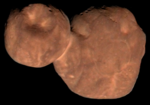|
2019 AQ3
2019 AQ3 is an inclined near-Earth object of the small Atira group from the innermost region of the Solar System, estimated to measure 1.4 kilometers (0.9 miles) in diameter. Among the hundreds of thousands known asteroids, 2019 AQ3's orbit was thought to have likely the smallest semi-major axis (0.589 AU) and aphelion (0.77 AU), that is, the orbit's average distance and farthest point from the Sun, respectively.[6] The object was first observed on 4 January 2019, by astronomers at Palomar's Zwicky Transient Facility in California, with recovered images dating back to 2015.[1][2] The record for smallest semi-major axis was beaten by another asteroid, 2019 LF6, with 0.555 AU.[7] Orbit and classification2019 AQ3 orbits the Sun at a distance of 0.40–0.77 AU once every 5 months (165 days; semi-major axis of 0.589 AU). Its orbit has an eccentricity of 0.31 and an inclination of 47° with respect to the ecliptic.[3] The body's observation arc begins with a precovery taken by Pan-STARRS at Haleakala Observatory in October 2015, more than 3 years prior to its official first observation at the Zwicky Transient Facility on 4 January 2019.[1] It has a minimum orbit intersection distance with Earth of 0.22 AU or 88 lunar distances.[3] Aphelion2019 AQ3's orbit has the third-smallest aphelion of any known asteroid in the Solar System, never distancing itself more than 0.774 AU from the Sun (77% of Earth's average orbital distance).[6] Before its discovery, the record was held by (418265) 2008 EA32 at an aphelion of 0.804 AU, which is notably larger. 2019 AQ3's orbit also has a semi-major axis below that of Venus (0.723 AU) and an orbital period of 165 days, which is the third shortest among all asteroids.[8] Atira class2019 AQ3 is a member of the small class of Atira asteroids,[3] which are also known as Apoheles or interior-Earth objects, as their orbits are confined inside that of Earth's. This makes their discovery difficult, as they stay relatively close to the Sun when observed from Earth, never reaching a Solar elongation of more than 90°, often much less. Only 19 such asteroids are known, 14 of which still reach 90% Earth's distance from the Sun over the course of their orbit.[9] InclinationThe asteroid's orbit is also highly inclined with respect to the plane of the Solar System, at more than 47°, the highest inclination of any known Atira asteroid,[9] although there are many near-Earth asteroids with even higher inclinations.[10] 
PerturbationsOn the short-term, 2019 AQ3 has a fairly quickly-changing orbit. Between 1600 AD and 2500 AD its aphelion distance lowers slightly from 0.7746 to 0.7725 AU, its perihelion distance increases slightly from 0.4025 to 0.4046 AU, and its inclination increases slightly from 47.19 to 47.25°. It is not subjected to a Kozai resonance because although its eccentricity and inclination oscillate in synchrony (when the eccentricity reaches its maximum value, the inclination is at its lowest and vice versa) over a long period of time, the value of the argument of perihelion circulates; the Earth-Moon system and Jupiter are its dominant perturbers.[12] Numbering and namingAs of April 2024[update], this minor planet has neither been numbered nor named by the Minor Planet Center.[1] Physical characteristicsThe object's diameter is estimated at 0.9–2 kilometers (0.56–1.2 miles), which corresponds to an geometric albedo range of 0.05 to 0.25 for an absolute magnitude of 17.376.[4][5] The Minor Planet Center also considers 2019 AQ3 to be larger than 1 kilometer.[1] However, these are estimates with no published radar or infrared measurements providing a more precise value for the body's diameter. As of April 2024[update], 861 kilometer-sized near-Earth asteroids have been discovered.[13] References
External links
|
||||||||||||||||||||||||||||||||||||||||||||||||||||||||||||






